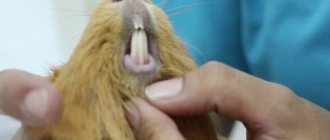- home
- General information
10/21/2018 The hamster is one of the miniature representatives of the rodent family. Before getting a pet, it is very important to study its anatomy. This way you can better understand how to care for it without causing damage to your health. The animal has a fragile body structure, so it must be carefully supervised.
The anatomy of a hamster is similar to other mammals, but there are some differences.
Anatomy of the Syrian hamster
A distinctive feature of hamsters is the presence of cheek pouches. They are located on both sides of the jaws. The bottom of the pouches is located near the shoulder joint. They use them to carry food to secluded places. If the pet completely fills these bags, its head will double in size. It extracts food from its cheek pouches using its paws. The bags can hold 18 g of food or more.
The animal can use its cheek pouches as defense. If danger approaches, he inflates them with air, which makes them seem scarier.
There are 16 teeth in the oral cavity. Of these, 12 are molars for chewing food and 4 are incisors. A characteristic feature of the rodent family is the absence of fangs. There is a void (diastema) between the incisors and chewing teeth.
The animal's incisors are constantly growing, so it is necessary to give the pet wooden objects and solid food. If the incisors are not ground down, they will reach large sizes. Then it will be difficult for the animal to close its mouth and chew. Subsequently, you will have to contact a veterinarian for an operation to shorten the incisors.
The hamster's skeleton is identical in structure to other mammals, but the bones are very fragile. If the animal jumps or falls from a height, it will break limbs and may damage internal organs. Hamsters are active animals; they love to climb heights, so they often have broken legs.
The structure of the internal organs is similar to other animals. A distinctive feature is the structure of the stomach (two-chamber), consisting of 2 sections:
- The function of the front is to soak food.
- Digestion occurs through the glandular section.
The distance from the anus to the genitals will help determine the sex of the animal. In females it is 3 mm, in males it is from 1 to 1.5 cm.
Other interesting anatomical features of funny rodents
Dentofacial apparatus
The number of teeth in a hamster is 16 (8 on the upper jaw and 8 on the lower, with the number of incisors being 2 each on the upper and lower jaws, and the number of molars being 6 each). Incisors do not have roots, due to which they have the ability to grow throughout the life of the animal. These teeth are covered with yellow enamel, which prevents excessive wear of the incisors.
Lateral glands for marking territory
Like many other animals, hamsters have special organs that secrete a special secretion. These organs in a hamster are the lateral glands, located on the back behind the ears and representing two inconspicuous black dots. The secret secreted by this organ allows the hamster in the wild to mark its territory and participate in the race for females.
Anatomy of the Djungarian hamster
The Djungarian hamster can be distinguished from the Syrian by the presence of hair on the limbs, by the color of the hair, and by the gray stripe that runs from the head to the tail. The Dzungarian hamster grows up to 10 cm in length, and the Syrian hamster up to 20 cm. The Dzungarian hamster bears the fetus in 19–22 days, and the Syrian hamster in 16 days. In the female, the uterus is divided into 2 parts.
Hamsters have identical ears. They perform the functions of hearing, coordination and maintaining balance.
First aid
It’s not worth applying the bandage yourself, the limb is small, and the hamster is already in pain. Before visiting the veterinarian, you can give him first aid. It consists of limiting physical activity as much as possible so that the animal does not harm itself. In this case, it is removed from the cage into a small box or container. A drinking bowl and feeder are placed in the temporary housing, and the bottom is covered with plain paper. It is noticed that it does not arouse interest in the pet, which means that he will not stir it up.
Did you know? In Vietnam, keeping hamsters at home is prohibited by law, as they carry dangerous infectious diseases. The violator faces a fine of $2,000.
What is a hamster's body temperature?
The normal body temperature for the animal is 37.5–38.5 degrees. It is measured rectally. It can be low or high. A low temperature indicates the presence of infection. In this case, you should use a heating pad with warm water wrapped in a cloth and apply it to the animal’s body. The heating pad must be kept on for 10 minutes, then wrap the animal in a warm towel and contact a veterinarian.
An elevated temperature also indicates the presence of an infection in the body. In this situation, the rodent should be placed near a windowsill or refrigerator where there is a cool place. Don't put off visiting the veterinarian.
Cover
Includes a description of the hamster's fur. The coat is soft, short and very thick. Gives the animal volume and smooth lines of the body and head. The legs including feet, tail and ears are covered with shorter and sparse hair.
Flaws
Sparse, uneven, wrinkled coat. The ears, tail and paws are not covered with hair.
Vices
Large areas of the body without hair.
Does a hamster have a tail?
If you look closely, you will notice that the animal has a small tail. Depending on the type of animal, the length of the tail ranges from 7–10 mm. In a fit of rage, the female can bite off the tail of the male.
The animal needs a short tail to protect the anus from pathogens. Wet tail disease is common among hamsters. One of the reasons is diarrhea, which appears due to poor quality food, unsanitary conditions in the cage and dirty water. In 90% of cases, hamsters die from the disease if they do not contact a veterinarian in time.
A hamster needs a tail to move and balance.
Content Rules
The life of a Syrian hamster is short, so the task of a caring owner is to do everything possible to make the pet comfortable in its new home.
Cell selection
The hamster needs a spacious cage and a house - a cozy hole where he can rest, stock up, and hide from bright daylight and excessive attention. You can find many options for small rodents on sale. There are 2 main parameters that should be taken into account when choosing a cage for your pet – dimensions and material of the product.
Syrian hamsters are active and mobile, and due to their natural characteristics, they need spacious housing. The larger the cage, the more comfortable he will feel. The minimum size for one pet is 30x30x45 cm. For good air circulation, you should choose a cage whose width is greater than its height.
It is recommended to choose cages with metal bars. Less preferable options are plastic structures or an aquarium or terrarium made of glass.
Design features.
- Cage with metal bars. This product provides high-quality air circulation and reliably protects the animal from other pets. Among the disadvantages: part of the filler often ends up outside the cage.
- Plastic cages. They are easy to use, easy to clean and equipped with additional accessories to entertain the animal (labyrinths, ladders). The disadvantages include the fragility of plastic, since hamsters often chew holes in such cages. When choosing products, you need to focus on the quality of the material. It should not emit toxic odors that could cause serious health problems for rodents.
- Aquariums or terrariums made of glass. Among the main advantages: no debris spills out of this design, transparent glass does not make it difficult to monitor the life of the pet. Cons: difficulty in cleaning inside the home and lack of good ventilation.
Also, when choosing a cage for your pet, you need to consider the following points:
- The distance between the cage bars should be min 0.5 cm.
- The presence of a wide door to make it convenient to stick your hand inside to serve food and clean your home.
- The cage size for 2 hamsters should be at least 60x60x90 cm.
- The height of each floor of a 2-story structure is not less than 25 cm.
Manufacturers provide a wide range of cages for hamsters. Popular designs include:
- standard products made from metal rods;
- modular;
- combined products with a plastic body and metal grilles.
When choosing a cage, you need to make sure that it is safe and non-toxic. It is better to give preference to products from well-known manufacturers or purchase housing for pets from trusted suppliers.
Arrangement
For the full development of the Syrian hamster, the cage must be equipped with the following items:
- A filler that absorbs unpleasant odors and makes cleaning much easier. When the temperature in the room drops, the pet may burrow into it to keep warm. Good bedding options are special fillers for rodents in the form of wood pellets, sawdust, and high-quality hay. It is prohibited to use cat litter, fabric, or newspaper.
- A running wheel, the size of which is important to choose, taking into account the size of the animal. This is not a whim or a decorative item, but an important element for keeping the animal in excellent physical shape. Lack of activity can lead to obesity, problems with the heart, liver, and organs responsible for digestion.
- Perches, ladders, labyrinths for additional activity. Hamsters prefer simple toys made from natural materials (branches, cardboard tubes, etc.).
- Water bowl.
- Mineral stone for grinding teeth. Rodents' teeth grow constantly, and if they are not periodically ground down, they will cause inconvenience and dangerous diseases. In pet stores you can buy monolithic chalk bars and mineral salt.
- A feeder attached to rods, or a heavy floor-mounted version that is difficult to turn over.
- A house (mink) securely fixed in the cage, otherwise the hamster will move it all the time.
- Toilet tray. Some hamsters can be trained to go to the toilet in one place.
All accessories must be selected from safe and durable materials, since hamsters will definitely chew them. This applies to all objects, including the cage. It is useless to wean the animal from this activity; this is the natural instinct of a hamster, which needs to grind down its teeth.
Choosing a location for the cage
The location of the cell is of no small importance. When choosing a location for the cage, you need to consider the following criteria:
- Providing a good view from the cage . The hamster must see everything that is happening around. Natural instincts force animals to always be on guard, since in natural conditions they are easy prey for predators. You should also place the cage on a certain height (table, cabinet).
- Temperature and humidity . It is not recommended to place the cage on the balcony or loggia, and the bathroom is also not suitable. During the heating season, the cage should be kept away from the radiator and other heating devices. It is also important to protect the rodent from drafts. The hamster's home should not be located near an open window or vent. Colds and other diseases reduce a hamster's lifespan.
- Noise, loud and sharp sounds . Screaming, knocking, loud noises can greatly frighten an animal. Syrian hamsters, like most rodents, are highly sensitive to noise. You cannot place a cage with a hamster in close proximity to a TV, stereo system, or mobile phone. For your pet's safety, you should choose a place away from electrical appliances that emit radiation.
- Protect furniture and interior items . When setting up a house, rodents drag into the cage everything that will be nearby (curtains, bedspreads, pieces of upholstered furniture).
- No pungent odors . You cannot leave a cage with a pet in a room where renovation work is underway. Harmful odors (acetone, paint and other chemicals) will have a detrimental effect on the health of the rodent. Smoking is also prohibited near the cage.
By choosing a suitable place for your hamster's cage, you can provide him with comfortable living conditions.
How is a mouse different from a hamster?
A mouse differs from a hamster in appearance. The main differences are:
- The length of the tail in a mouse reaches the size of the body itself; in a hamster it is very short, almost invisible.
- The skull has a special structure, so the muzzle of a mouse is elongated and narrow, while that of a hamster, on the contrary, is wide and flattened.
- The mouse’s body is elongated and thin, while our pet’s is short with thick fur, which visually creates a rounded shape.
- The coat color of rodents is different. In a mouse, gray and white colors predominate; in a hamster, they are multi-colored (red, black, white, spotted).
The hamster and the mouse are related and belong to the rodent family.
The lifespan of hamsters is from 2 to 3 years. The weight of an adult animal is about 130 g. Hamsters have brains, but they are not able to recognize their owner. To do this we use our sense of smell. His brain cannot perform complex activities, but can be trained.
Care
Compared to other pets, the Syrian hamster is an unpretentious pet. With the right approach, caring for it will not cause much trouble.
What to feed
Adequate nutrition is the key to the health of the Syrian hamster. When feeding, it is important to adhere to the main rule - they should not be overfed. You need to offer food in portions 2 times a day at the same time.
Nutrition should be balanced and varied:
- Grain mixture.
- Grass and greenery.
- Vegetables, fruits and berries.
- Drinking water at room temperature.
It is important to monitor the quality and composition of food; if there is a deficiency of vitamins and minerals, hamsters become vulnerable to infections and diseases.
It is forbidden to give Syrians citrus fruits, fried seeds, fresh bread, chocolate and other sweets, cabbage, butter and fish oil.
Taming
The Syrian hamster is quite easy to tame and easily adapts to a new environment. It is better to start accustoming a rodent to handling at the age of 2-3 months. At the same time, it is important not to scare the animal or hurt it, otherwise the hamster will no longer be able to trust its owner.
The taming process must take place in stages. Before starting acquaintance, you need to make sure that there are no irritating factors near the cage - noise, bright light, other pets. If the hamster does not cooperate, you can lure him in with a treat.
You cannot use force, raise your voice, as the furry pet will be afraid, and avoid all contact with humans.
Cleaning the cage
It is recommended to carry out cleaning according to the following recommendations:
- Change the filler completely 2-3 times a week.
- Check the pantry, eliminating pet supplies that may go bad.
- Change the water in the drinking bowl daily.
- Wash the feeder and drinkers thoroughly. To completely disinfect them, they should be doused with boiling water; the use of chemicals is not recommended.
- Handle accessories and toys (labyrinths, tunnels, wheels, houses).
Timely cleaning of the cage will help get rid of the characteristic unpleasant odor.
Communication
Syrian hamsters are sociable and friendly; they need constant contact with their owner, who is required to surround the furry animal with unobtrusive love and care. It should be noted that excessive attention can cause stress, which will negatively affect the health of the pet.
You also need to take time to restore order and monitor the life of the rodent. Animals are active at night, so the optimal time for communication is in the evening.
Hamsters are nocturnal, so waking them during the day is not recommended.
Breeding
Syrians reach sexual maturity at the age of 5-6 weeks. But the first mating can be carried out no earlier than 3-4 months, since the female’s body is not yet ready to bear offspring until this time. Pregnancy lasts 16-19 days. The lactation period takes up to 24 days. One female is capable of producing up to 3-5 litters per year, each with an average of 6-7 cubs.
It is forbidden to cross hamsters from the same litter - this can cause genetic diseases and abnormalities in the offspring.
Harm to a person - a farmer
It’s not hard to imagine the enormous harm wild hamsters cause to agriculture, farmers, gardeners and gardeners!
The huge number of pests and the ability to adapt to any conditions allow them to infest all rich territories, and the ability to build complex burrows makes them difficult to catch and destroy.
Everything that is grown in the garden is a delicacy for them, and hamsters will not give up so easily. Farmers face a serious struggle for their harvest!
In addition, wild hamsters can bite humans or domestic animals and livestock, which will most likely result in infection with various infections (up to 30 types), and possibly death.
The fleas that live on them and suck blood are no less dangerous. Rodents pose a serious threat, but the fight is all the more important!
Behavior and natural instincts
Babies are big sleepyheads, they like to sleep during the day in a cozy hole, and wakefulness begins in the evening and can last all night. You need to remember this when planning to purchase a rodent.
Sociable and charming furries love children and make contact easily. They are practically silent animals and can even be trained. They will never take revenge for an insult; they are affectionate and friendly. The fun starts that they periodically organize in the cage mean only one thing - the hamsters are having fun and they are inviting you to play.
Some aspects of a rodent's behavior may surprise the owner, but it is not difficult to unravel such actions. If a baby funnyly pecks at the bottom of his house, most likely he wants to refresh himself and is looking for food. The fear of an animal can be determined if it suddenly freezes without moving or sneaks around the cage. A funny stance on its hind legs indicates that the baby is very interested in something. It is extremely rare that in this position a Siberian hamster can show his grin and even try to growl - this means that it is better not to touch him, he is aggressive.
If you add a couple or several friends to a hamster, it is best to do this in the first days of life; adaptation will be painless. But if you allow this to happen at a fairly mature age, then friendship between neighbors may not happen. A female and a male can live in the same cage only when you are going to breed offspring. Reproduction occurs quite quickly.
Siberians are very clean; all their free time they are busy with hygiene procedures: washing their paws, brushing their fur.
Skeletal system
To begin with, it is worth noting that the skeleton of these cute fluffies is very fragile. The animal loves to cover various distances, and at the same time they make dangerous jumps, because they have no fear of heights.
The musculoskeletal frame of this rodent cannot absorb shocks and shocks, for example, like a cat’s. It is for this reason that limb fractures often occur due to clumsy movements.
Is it worth waking up the home?
If the hamster stops playing and sleeps all day, then he has gone into hibernation. There are two options here: either wake him up or let him sleep. What is the right thing to do? And here it all depends on the physiology of the hamster.
It is recommended to wake up your pet if he is numb from the cold. But this must be done according to the rules. You need to immediately warm the animal well; to do this, take it in your hands. Heating devices cannot be used for this.
Hold it in your hands and stroke it gently. You will notice how over a period of time his body will become warmer and his breathing will become more frequent. After which your pet will begin to slowly move, which means that he is waking up.
If the rodent fell into hibernation due to severe stress, then it is better to let it sleep well. How long his sleep will last depends on the degree of stress and the pet’s health.
Winter dream
With the arrival of winter, hamsters begin to realize that the days have become shorter and it is time to sleep. In order for rodents to maintain the required body temperature during this period, they need to constantly eat. The hamster is an intelligent and economical animal. He knows that if he constantly eats up his reserves, he may not live until spring. Therefore, in winter, rodents hide in their house and go to bed until spring.
At home, the hamster sleeps during the day and runs around at night. But do they hibernate?
Hibernation in domestic rodents
The hamster has its own cycle according to which it lives. At home, hibernation does not occur every year. But when hamsters sleep day and night also on their backs, the first thing the owner thinks about is that the pet is probably dead.
There is no need to panic, first you need to check whether the animal has died or has simply become numb for a while. Yes, this happens in rodents of this species. In order to find out what happened to him, it is worth knowing the reasons for the numbness.











